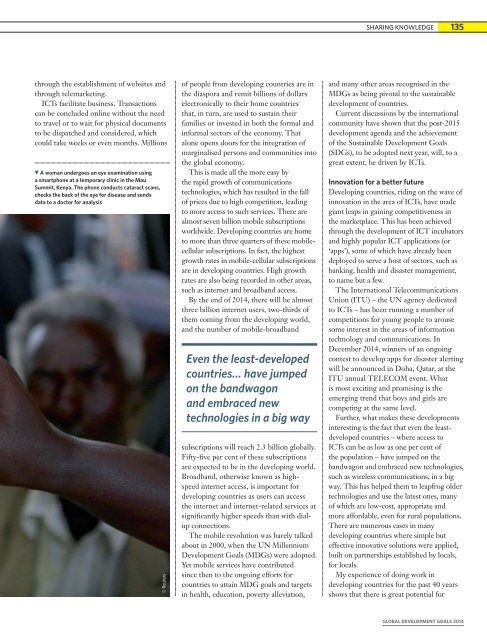FAMBB
FAMBB
FAMBB
You also want an ePaper? Increase the reach of your titles
YUMPU automatically turns print PDFs into web optimized ePapers that Google loves.
SHARING KNOWLEDGE135through the establishment of websites andthrough telemarketing.ICTs facilitate business. Transactionscan be concluded online without the needto travel or to wait for physical documentsto be dispatched and considered, whichcould take weeks or even months. MillionsA woman undergoes an eye examination usinga smartphone at a temporary clinic in the MauSummit, Kenya. The phone conducts cataract scans,checks the back of the eye for disease and sendsdata to a doctor for analysis© Reutersof people from developing countries are inthe diaspora and remit billions of dollarselectronically to their home countriesthat, in turn, are used to sustain theirfamilies or invested in both the formal andinformal sectors of the economy. Thatalone opens doors for the integration ofmarginalised persons and communities intothe global economy.This is made all the more easy bythe rapid growth of communicationstechnologies, which has resulted in the fallof prices due to high competition, leadingto more access to such services. There arealmost seven billion mobile subscriptionsworldwide. Developing countries are hometo more than three quarters of these mobilecellularsubscriptions. In fact, the highestgrowth rates in mobile-cellular subscriptionsare in developing countries. High growthrates are also being recorded in other areas,such as internet and broadband access.By the end of 2014, there will be almostthree billion internet users, two-thirds ofthem coming from the developing world,and the number of mobile-broadbandEven the least-developedcountries… have jumpedon the bandwagonand embraced newtechnologies in a big waysubscriptions will reach 2.3 billion globally.Fifty-five per cent of these subscriptionsare expected to be in the developing world.Broadband, otherwise known as highspeedinternet access, is important fordeveloping countries as users can accessthe internet and internet-related services atsignificantly higher speeds than with dialupconnections.The mobile revolution was barely talkedabout in 2000, when the UN MillenniumDevelopment Goals (MDGs) were adopted.Yet mobile services have contributedsince then to the ongoing efforts forcountries to attain MDG goals and targetsin health, education, poverty alleviation,and many other areas recognised in theMDGs as being pivotal to the sustainabledevelopment of countries.Current discussions by the internationalcommunity have shown that the post-2015development agenda and the achievementof the Sustainable Development Goals(SDGs), to be adopted next year, will, to agreat extent, be driven by ICTs.Innovation for a better futureDeveloping countries, riding on the wave ofinnovation in the area of ICTs, have madegiant leaps in gaining competitiveness inthe marketplace. This has been achievedthrough the development of ICT incubatorsand highly popular ICT applications (or‘apps’), some of which have already beendeployed to serve a host of sectors, such asbanking, health and disaster management,to name but a few.The International TelecommunicationsUnion (ITU) – the UN agency dedicatedto ICTs – has been running a number ofcompetitions for young people to arousesome interest in the areas of informationtechnology and communications. InDecember 2014, winners of an ongoingcontest to develop apps for disaster alertingwill be announced in Doha, Qatar, at theITU annual TELECOM event. Whatis most exciting and promising is theemerging trend that boys and girls arecompeting at the same level.Further, what makes these developmentsinteresting is the fact that even the leastdevelopedcountries – where access toICTs can be as low as one per cent ofthe population – have jumped on thebandwagon and embraced new technologies,such as wireless communications, in a bigway. This has helped them to leapfrog oldertechnologies and use the latest ones, manyof which are low-cost, appropriate andmore affordable, even for rural populations.There are numerous cases in manydeveloping countries where simple buteffective innovative solutions were applied,built on partnerships established by locals,for locals.My experience of doing work indeveloping countries for the past 40 yearsshows that there is great potential forGLOBAL DEVELOPMENT GOALS 2014


